BL: Back Loops
BLO: Back Loops Only
TBL: Through Back Loops
Puzzled by what you’re supposed to do when you see instructions to work in the “back loops only” or when you encounter instructions to crochet “through back loops” of certain stitches? It isn’t surprising if you don’t have a clear understanding of this concept. There are crochet teachers who don’t explain this clearly, and it can be challenging to find the information online.
Last time I did an Internet search for “back loop,” I was amazed at how many different ways this simple phrase could be used and interpreted. I found web pages about a wide variety of different topics including windsurfing and knitting. I don’t want any crocheters who frequent this website to have to dig too deep to find information about back loops as they pertain to crochet; so, I thought I’d take this opportunity to explain what exactly the “back loops” of your crochet stitches are.
Back Loops vs Front Loops in Crochet
Back and Front Loops of Crochet Stitches: This photo shows you what front loops and back loops look like in crochet.
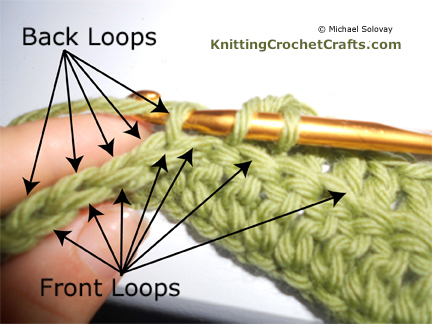
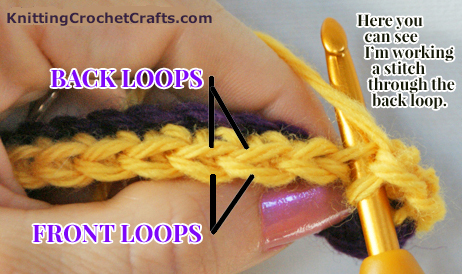
When you tilt your crochet work a bit and look at the top of it, you’ll see that each of your crochet stitches has two loops at the top — a front loop and a back loop.
To crochet any standard, basic crochet stitch, you would work into the next pair of front and back loops together. But you don’t always have to work into both loops together, which is why the differences between front loops and back loops start to become important.
Of course you already know what “back” and “front” mean. The loop in front is the “front loop” and the loop in back is the “back loop”. These are always designated in relationship to you, so when you turn the work over, what used to be the front loop isn’t the front loop any more. It then becomes the back loop, because after turning the work it’s no longer the loop in front.
Make sense?
One of the things that keeps crochet interesting: Small variations in crochet hook placement can create significant differences in the outcomes of your crochet projects. When you look through the photos posted below, you’ll see some examples of just how dramatic the differences can be — and these crochet stitch variations are all created by making slight variations in where you insert your crochet hook into the fabric to work each stitch.
Crochet Stitches Worked Through the Back Loops (TBL)
Let’s take a closer look at the difference between a “back loop only” stitch and a regular stitch.
When you crochet through only one loop, the fabric is structurally different than it would be if you were to crochet through both loops. The look of the fabric will be different. The amount of stretch you get will be different. Your gauge is likely to be different.
You can work in the back loops of just about any crochet stitch — single crochet, double crochet and so on.
Standard Single Crochet Stitch vs Back Loop Single Crochet Stitch
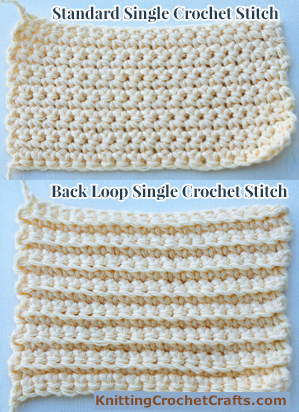
Let’s use single crochet as our first example.
Compare pictures of standard single crochet stitch and back loop single crochet stitch.
Here you can see pictures of both the standard single crochet stitch and back loop single crochet. The standard single crochet stitch is worked through both loops. Back loop single crochet is worked through only one set of loops; you guessed it — the back loops.
Structurally, these fabrics are really different. Standard single crochet has a sturdier, denser feel to it. It has a smoother, less textured appearance.
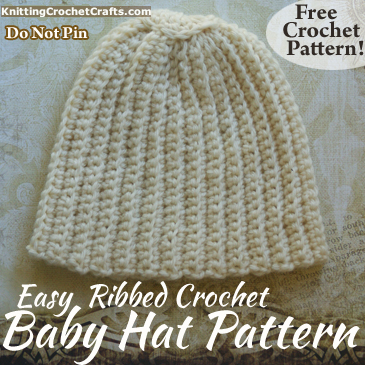
In contrast, back loop single crochet has a stretchier, more fluid feel to it. The appearance is much more textured, as it has interesting ridges on the surface of the work. If you rotate this fabric on its side, you can take full advantage of the stretch and mimic the look of a knitted rib stitch. You can see an example of this in the baby beanie pictured at left.
How to Single Crochet Through the Back Loops (TBL)
To work single crochet through the back loops, you go through all the same steps you go through when working standard single crochet; the only difference is you work only in the back loop instead of working through both loops. Here’s a quick tutorial:
Insert Your Crochet Hook Into the Back Loop Only of the Next Stitch to Be Worked:
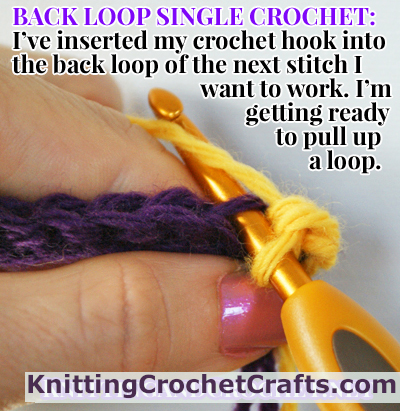
Pull Up a Loop:
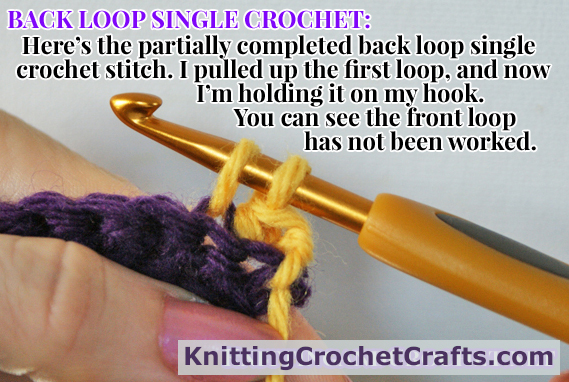
Yarn Over Your Hook and Pull It Through to Complete the Stitch:

Repeat Across the Row or Round As Desired.
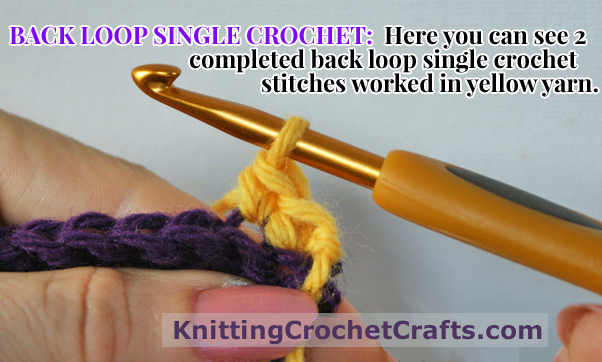
I find the first stitch in back loop single crochet to be awkward. When I was first learning to crochet, I had to practice the back loop single crochet quite a bit before I got the hang of it.
For me, working the first stitch in every row of the back loop single crochet involves an extra step – namely, getting the yarn out of the way. This is now second-nature to me, but it took a lot of practice to get to that point.
If this is the case for you, too, just do what you can to get the yarn out of the way before you work that first stitch – move it, reach under it with your hook, or work around it however you can. I end up reaching under it, but before I figured out how to do that I would actually physically just pick it up and hold it up out of the way ’til after I’d inserted my hook into the proper spot. Then I’d drop the yarn and use it to complete the stitch as usual.
All this might seem like a nuisance, but the yarn only gets in your way like that for the first stitch in every row – just do whatever you have to do to get that first stitch worked. It gets easier with practice.
Standard Double Crochet Stitch vs Back Loop Double Crochet Stitch
Here you can see pictures comparing the standard double crochet stitch, which is worked through both loops, versus the double crochet stitch worked through the back loops:
Standard Double Crochet Stitch vs Back Loop Double Crochet Stitch
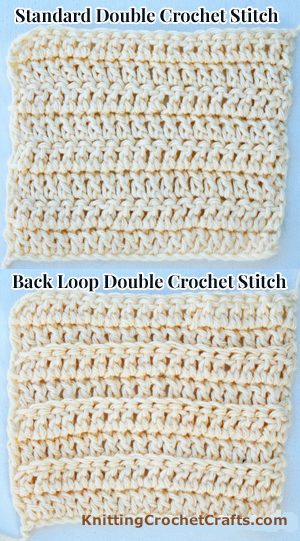
Here you can see pictures comparing the standard double crochet stitch, which is worked through both loops, versus the double crochet stitch worked through the back loops:
More Crochet Stitches Worked Through the Back Loops
You can work just about any type of crochet stitch through the back loops only to create interesting variations. Slip stitch, half double crochet, treble crochet, double treble crochet and triple treble crochet can all be worked through the back loops only if you want to give these fabrics additional texture and stretch.
Crochet Abbreviations Relating to Back Loops
You’ll sometimes see the following crochet abbreviations relating to back loops:
- BL = back loop(s)
- BLO = back loop(s) only
- TBL = through back loop(s)
References
- People have been crocheting in the back loops of their stitches for more than a century. Sophia Frances Anne Caulfield and Blanche C Saward included instructions for back loop single crochet in their 1882 book called The Dictionary of Needlework. They refer to the stitch by a couple of different names: the “ribbed stitch” and the “Russian stitch”. Their book also incorporates back-loop-only stitches into various complete crochet projects such as a “square for a quilt”. The authors describe this technique as “working upon the back of the stitches so as to form a ridge.”
- Sylvia Cosh and James Walters covered back loop stitches in detail in their classic crochet stitch dictionary called The Harmony Guide to Crochet Stitches. They’ve shared instructions plus stitch diagrams for back loop single crochet, back loop half double crochet, and many other crochet stitches.
Learn More About Crochet:
- Click here to find our picks for the best crochet books.
- Click here to find crochet stitch tutorials and instructions.
- Click here to learn more crochet techniques.
- Click HERE to Find Fabulous Yarn for Crochet and Knitting
- Click here to learn about crochet hooks.
- Click here to find my favorite crochet project bag.